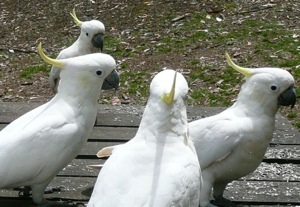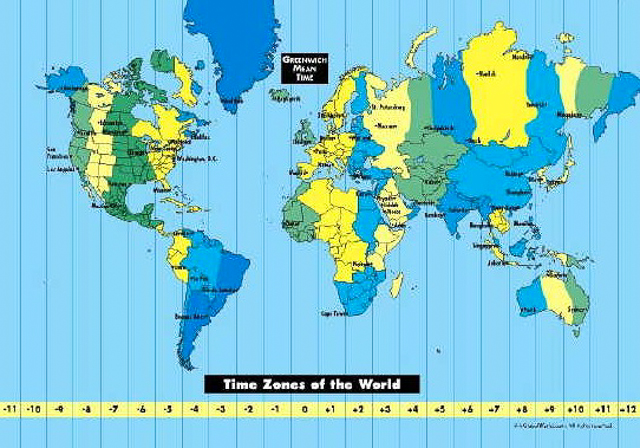
by Loti | Mar 8, 2014 | Australia, Birds, United States
Sydney, Australia. Pretty cool birds. But what are they? Surely there is an internet app for identifying birds. Well, of course! Actually the one I found and like is the Merlin Bird app produced by the Cornell Lab of Ornithology. Covering 285 species, I identified my first birds using it this week, wild turkeys walking across the road in North Carolina. It is easy enough for a child to use (just my speed) and sends info to Cornell who uses it to track bird populations. So I am helping science while birding, my new favorite sport. And move over all you football fans. According to the US Fish and Wildlife services, birding is the #1 sport in the US (maybe a little biased). And it is free! Just look outside and no matter where you are, there are birds. Some 10,000 species worldwide. And the Merlin app is also free. Sweet! Well, the birds pictured are Sulphur Crested Cockatoos, only found in the wild in Australia and New Guinea. We saw them in a local park while visiting Sydney. Now I have 6 birds listed in my new Birder’s Journal. Only 8,393 to go to match Phoebe Snetsinger’s world record of birding, the most of anyone in the world at the time of her death. Well, I better go get...

by Loti | Jan 20, 2014 | Animals, Australia, Birds, Endangered Species, Environment, Flowers, Food, Health, Insects, Plants
Adelaide, Australia. Within walking distance of our hotel, I discover a magical botanical garden. Free to the public, in the middle of downtown, this 125 acre oasis includes a rainforest under glass. The forest is housed in the largest single span greenhouse in the Southern Hemisphere (for those of us geography challenged, the Southern Hemisphere is all the land below the equator including Anartica, Australia, most of South America and a third of Africa.) Entering the glass 2 story structure, the air is misty and buzzing with activity, from birds, insects, plants growing and 1,000 misting nozzles. I have always heard how important the rainforest (defined as a dense forest receiving 90-180 inches of annual rainfall) is to our global ecosystem, but I had no idea 50% of the world’s plants and animals live in them. And many of our medicines (some anti cancer and leukemia drugs for starters) come from rainforest plants. Yet we are losing 1-2 (and some biologists estimate the number is closer to 100) animal and plant species a day to extinction primarily from deforestation. Wow! So what can we do? I plan on learning more about the issues and possible solutions by joining a conservation club, visiting rain forests whenever I can and taking steps to recycle and be nice to our Earth. Once a species is gone, we can never get it back. And that sounds so...

by Loti | Oct 7, 2013 | Africa, Australia, Conquering Fear, Easter Island, Fiji, Food, Indonesia, Panama, Portugal, Travel, United States
Miami/FT Lauderdale . Arriving at our kicking off spot for the jet trip around the world, I am vacillating between being totally terrified (I mean what was I thinking about signing up for a trip with 23 people I don’t know) and feeling completely exhilarated (what an adventure). We visit 8 countries in just 22 days on our Airbus (which hold 24 travelers plus 3 pilots, one engineer, 4 flight attendants, a full time chef and 4 tour guides, plus an IPad to use). So just how far is it around the world? I was guessing 50,000 but it turns out it’s just under 25,000 miles, barely enough to get Silver medallion status on Delta. So if you have any minimal status on any airline, you have probably flown the equivalent of around the world. I just happen to be doing it all at one time. And which way do you want to travel? East to west or the opposite, west to east? As with so many things, I never really thought about it. Our pilots feel flying from East to West is much easier on jet lag. You generally arrive during daylight and then can go to bed at a normal time. Which is great as our entire trip is east to west. We leave for Panama in the morning for a short 2.5 hour trip with no time change so I think we will be safe from jet lag for a couple more days. By this time tomorrow, we will have traversed one of the largest locks in the world (the largest is in Belgium). The journey...

by Loti | Aug 13, 2013 | Animals, Australia, Environment, Food, Health
Australia. The view of a salmon farm from our single engine plane high above the waters of Tasmania looks pretty cool and well, pristine. So why when I ask the restaurant server “is the salmon farmed or wild” do I order something else if the answer is farmed? On researching, it turns out to be a hotly debated subject with lots of emotionally charged opinions including my own. As the fastest growing food production segment in the world (wow, I had no idea) with over 1.5 million tonnes (a tonne = 2,204 pounds) produced annually, it’s a lot of salmon! So what’s wrong with ocean farmed salmon? Well, according to Whole Foods, nothing as long as it is farmed to their 36 page Quality Standard guide. OK, so if not, higher levels of PCB’s, lower levels of Omega 3’s, residual antibiotics used to fight disease and the use of genetically modified feed by some farmers for starters. And what about environmental concerns? The spread of disease into wild populations, pollution, and the death of thousands of sea lions and seals by drowning in the netting or being killed by farmers protecting their fish are real issues. The good news, however, is the industry is improving dramatically and has started farming in inland closed system tanks which eliminate many of the problems. So next time I eat out, I’ll just stick with wild fish or maybe ask if the farmed fish is ocean raised or inland tank raised. Can’t wait to see the reaction to that question! ...

by Loti | Jul 9, 2013 | Africa, Australia, Easter Island, Fiji, Indonesia, Panama, Portugal, Time, Travel
Palm Beach, FL. Having just committed to a 3 week trip around the world beginning in Oct, I now find I need yellow fever shots, extra pages added to my passport, country visas. Yikes! We start in Florida traveling west to Panama, then Easter Island, Fiji, Australia, Bali, India, Kenya, Portugal and then back to Boston. So how do I keep up with the changing time zones? How many time zones even exist in the world and what is a zone? Well, there are 40 time zones according to one website (37 according to another). With a time zone referring to the Earth’s surface loosely divided by 15 degrees of longitude (not even sure what that means) there are 24 standard zones (see map) with another 16 zones that use 30-45 minute increments after the hour. The U.S. actually has 9 time zones (yep 9, including Alaska, Hawaii and Samoa). Ok, really? Yet, China has only one time zone for the entire country and then throw in daylight savings time. And how about outer space? The common practice is to use the time zone of the launch site. Wow, this is way too complicated. I am just glad I start and end in the same zone, 40 zones later (or is it 37?). >...

by Loti | Jun 25, 2013 | Animals, Australia, Endangered Species, Tasmania
Boston, MA. A stuffed Tasmanian Tiger seen at The Harvard Museum is something to behold. With stripes on its back and the features of a large dog or wolf, it was the world’s largest carnivorous marsupial (distinguished by the young being carried in a pouch).And one of only 2 marsupials where both sexes had a pouch. The last known tiger died in 1936 from neglect at The Hobart Zoo in Tasmania less than 2 months after it was declared a protected species. Hunted to extinction in Australia, Tasmania and New Guinea by European settlers, it is one of the most fabled, mystical animals of this century. But since it’s declared extinction, there have been thousands of unconfirmed sightings. In 1983, Ted Turner offered a $100,000 reward for proof of the continued existence of a tiger and as recently as 2005, an Australian magazine offered a million dollars for proof. Movies have been made including The Hunter starring Willem Dafoe, and numerous books have been written about the tiger. Even talk about cloning preserved DNA adds to the legend. So you never know. Extinct or not? Either way, a fascinating animal. Photo by Corrie Woods ...







